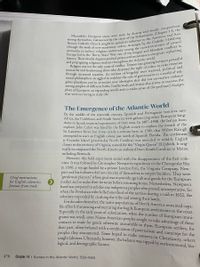Question
Summarize these pages. DO NOT REJECT PLEASE ALLOW SOMEONE TO SUMMARIZE.

Transcribed Image Text:and propagating religious rivalries throughout the Atlantic world.
Bious pluralism and to articulate new ideologies that did not necessitate violence
tong peoples of different faiths. Intellectuals and artists also strove to reassess the
ace of Europe in an expanding world, and to make sense of the profound changes
that were occurring in daily life.
The Emergence of the Atlantic World
By the middle of the sixteenth century, Spanish and Portuguese ventures into
Africa, the Caribbean, and South America were galvanizing other European king-
doms to launch imperial experiments of their own. In 1497–1498, the Italian-born
explorer John Cabot was hired by the English crown to explore the mouth of the
St. Lawrence River; but it was nearly a century later, in 1585, that Walter Raleigh
attempted to start an English colony just north of Spanish Florida. The settlement
at Roanoke Island (present-day North Carolina) was intended to solidify English
claims to the territory of Virginia, named for the "Virgin Queen" Elizabeth. It orig-
inally encompassed the North American seaboard from South Carolina to Maine,
including Bermuda.
However, this bold experiment ended with the disappearance of the first colo-
nists. It was followed by Christopher Newport's expedition to the Chesapeake Bay
in 1606: a voyage funded by a private London firm, the Virginia Company. New-
port and his followers did not conceive of themselves as empire builders. They were
"gentleman planters" whose goal was to provide agricultural goods for the European
market and so make their fortunes before returning home. Nevertheless, Newport's
band was prepared to subdue any indigenous peoples who proved uncooperative. So
when the Powhatan tribe killed one-third of the settlers during a raid in 1622, the
colonists responded by crushing the tribe and seizing their lands.
For decades thereafter, the native populations of North America remained capa-
ble of both threatening and nurturing the fragile European settlements on the coast.
Especially in the early years of colonization, when the number of European immi-
grants was small, some Native American peoples sought to take advantage of these
Conracts to trade for goods otherwise unavailable to them. European settlers., for
their part, often behaved with a combination of paternalism and contempt for the
peoples they encountered. Some hoped to make converts to Christianity, others
coucht laborers. Ultimately, however, the balance was tipped by environmental, bio-
Chief motivations
for English colonists:
fortune from trade
logical, and demographic factors.
470
Chapter 14 > Europe in the Atlantic World, 1550-1660

Transcribed Image Text:14
Europe in the
Atlantic World,
1550–1660
THE ATLANTIC OCEAN THRASHES the western shores of
Europe and Africa with waves that have traveled thousands of miles from
the American coasts. It links continents shaped by a wide variety of cli-
mates and ecologies. For most of human history, the limited movement of
peoples across the ocean meant that each region nurtured its own forms of
plant and animal life, and its own unique microbes and pathogens.
But in the sixteenth century, the Atlantic world became an arena of
cultural and economic exchange that broke down the isolation of these
ecosystems. Populations of humans, animals, and plants on once-remote
shores came into frequent and intense contact. Europeans brought dis-
eases that devastated the peoples of the Americas, along with gunpowder
and a hotly divided Christianity. Meanwhile, the huge influx of silver from
South America transformed (and eventually exploded) the cash-starved
European economy, along with the arrival of American stimulants such as
tobacco, sugar, and chocolate. The need for slaves to power the plantations
that supplied these consumer products fostered a vast industry of human
trafficking and caused the violent removal of nearly eleven million people from
Africa over the course of three centuries. Colonial ventures in North and
South America also created new social hierarchies and forms of inequal-
ity, which unsettled even long-established structures in Europe, too. The
indigenous peoples of the Americas were forced to deal with newly arrived
settlers and the meddling interference of distant imperial bureaucracies.
BEFORE
YOU
READ
THIS
CНАРТER
Expert Solution
This question has been solved!
Explore an expertly crafted, step-by-step solution for a thorough understanding of key concepts.
Step by stepSolved in 3 steps
